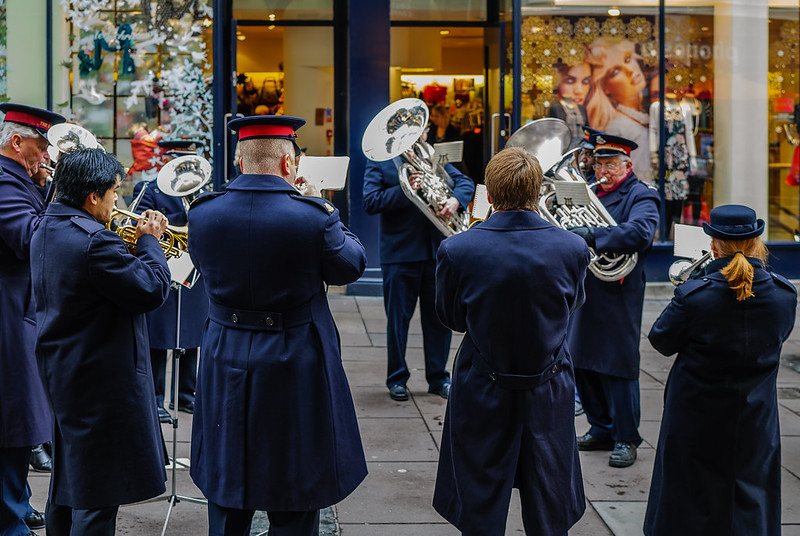There are not many iconic Australian events that don’t feature a Salvo brass band. The iconic, if dated outfit is a staunch feature of ANZAC Day and formerly the Carols by Candlelight. Whether they are marching down Swanston Street, or playing at your local shopping centre at Christmas time, the blast of reverberating sound is heard by thousands of people each year.
The Salvation Army has existed as a church and charity for over 150 years, making it one of the oldest functioning not-for-profit organisations in the world. Thirty years after it was founded in the streets of East London, the first brass band in the Salvos was introduced, and it has been a key part of their identity since.
Why has this iconic sound remained in the Salvation Army when more modern musical groups have grown in popularity within the church? Are they clinging onto a bygone era, something that should’ve ended years ago?
In 1865, the then-called “Christian Revival Society”, was formed on the idea of taking the message of God to the poor and underprivileged who were shunned by other established churches, and by doing so, bringing the church to the streets. While the Salvos have since moved away from the outdoors for their Sunday services, connecting with the community is still a major part of their mission.
Bruce Stevens was a Salvation Army Officer (minister) for three decades, working in and with communities across Australia to give people the help they need.
“As a Salvation Army officer, my job is to love people, simple as that,” he tells upstart.
Brass band music has been an important part of the fabric that makes up the Salvos to this day, contributing to the connection between the organisation and the communities they exist in. Stevens was appointed the Executive Officer of the Melbourne Staff Band (MSB) in 2014. They are known as Australia’s premier Salvation Army brass band and one of the world’s most recognised Salvo outfits.
“William Booth, the founder of the Salvation Army, he hated brass bands… but he recognised that they were a vehicle that could actually draw attention. They were a vehicle that could be used to share a message through the power of music,” Stevens says.
“Brass bands are so portable. The value of a brass band that can go and play in a town square or go to a shopping centre, things like that, it’s simple to do.”
He suggests that bands like the MSB and many corps (church) groups have remained in place due to strong leadership and direction, sighting MSB bandmaster Ken Waterworth who has had the role for over 25 years, as an example.
“[Ken Waterworth] thinks laterally. He’s just not about playing well, he’s about ‘how do we communicate well? How do we present well? How do we engage the audience?’” Stevens says.
“The best Salvation Army bands are not the ones who just play in church services. The bonus of them is to be in the community, which is really what the Salvation Army should be really doing all the time.”
The Salvation Army in Australia has a wide range of programs and camps that it runs nationally, but none have been more popular than ‘Just Brass’ which aims to “transform young lives through music.”
Darren Waterworth has been a part of the MSB’s percussion section since 1981 and has been involved with numerous musical programs during his time with the group. He tells upstart that ‘Just Brass’ has been able to connect families to the Salvos by running music programs in schools who don’t have one.
“They may be on a lower socioeconomic level, and they would go into a group and find people who are interested in wanting to make music but probably even more importantly, be part of something,” he says.
“They really see it as something to be part of, to educate, provide skills music-wise, and bring them in the back door of the Salvation Army … to play music and through connections and conversations with the people who run the program.”
Brass bands and brass music are a social connector in the Salvation Army. Whether it is the local corps band or the highs of the MSB, the sound that is synonymous with the Red Shield has been used to bring people together and lead them to the help and comfort they might need.
Stevens says that it could have been any group of instruments chosen by the Salvos, but because of the long-lasting tradition within the Salvation Army of brass music, people have become accustomed to it.
“People of my generation, who have grown up with the sound of brass band music, it’s the way they connect with their emotions.
“It’s a way in which God gets their attention and speaks words of encouragement or comfort or inspiration to them so I think that’s part of the DNA of the Salvation Army.”
Photo: Salvation Army Brass Band plays Christmas carols in Bath by velodenz available HERE and used under a Creative Commons license. This image has not been modified.







